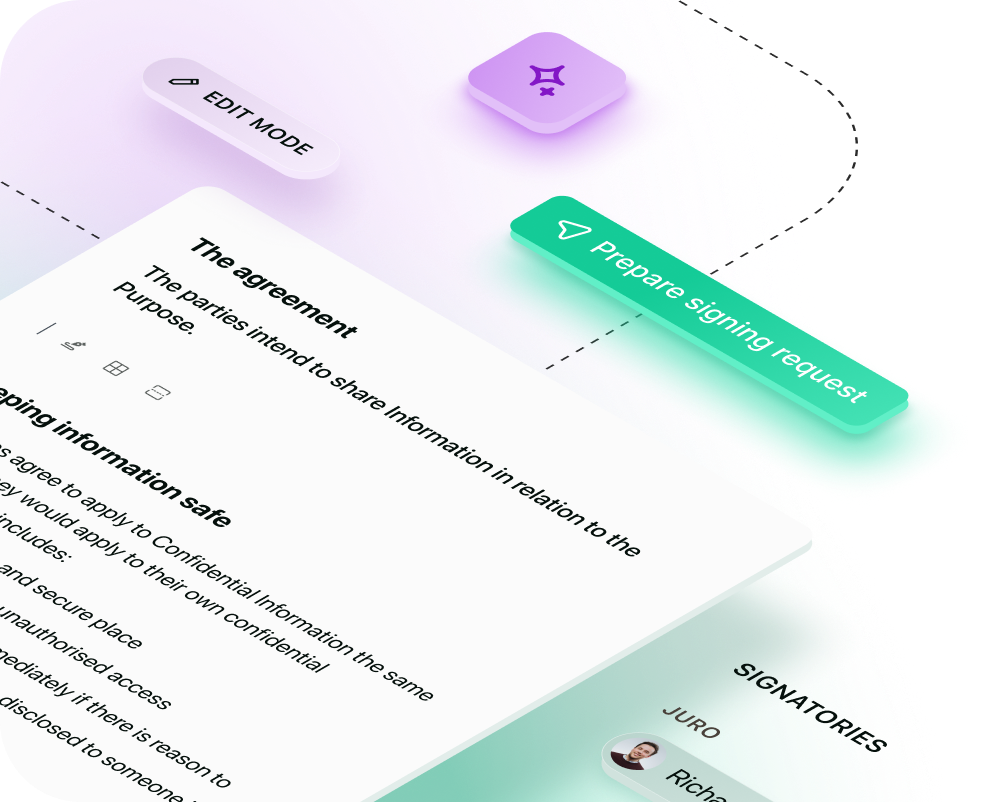Solutions
Customer Support
Resources
Add this free employee confidentiality agreement template to your stack of onboarding documents and HR contracts.




Confidentiality agreements are pivotal for protecting sensitive workplace information. In this guide, we'll explore confidentiality agreements in the context of the employee-employer relationship, and provide a free employee confidentiality agreement sample to get you started.
An employment confidentiality agreement is a legal document that creates a confidential bond between an employer and an employee. In this contract, the employee commits not to disclose any sensitive or proprietary information they learn during their employment.
Such an agreement is generally put in place when an employer has unique methods, business processes, or data that employees will be privy to during their work. For this reason, the employer puts a legal agreement in place to make sure this information isn't shared widely.
The primary role of an employment confidentiality agreement is to protect confidential workplace information from being shared or leaked.
A robust employment confidentiality agreement ensures that such information remains private and confidential, and can't be used against the employer or shared without their explicit consent.
An employee confidentiality agreement isn't too different from a generalised confidentiality agreement. However, it's drafted with the type of information an employee will be exposed to in mind, not an external party. This means that it's always better (and less risky) to use an employee confidentiality agreement with more specific terms, if the relationship you're looking to govern is an employee-employer relationship.

The task of drafting employment confidentiality agreements generally falls on the company's legal department, but it's usually the HR team that shares a copy of the employment confidentiality agreement with the new employee as part of their onboarding. This will often be shared at the same time as their employment contract, option agreement and other onboarding documents.
It's then up to both the employee and the employer to ensure that the agreements are signed, stored, and enforced.
Like this template? Grab our other popular employment contract templates:
A robust employee confidentiality agreement template should ideally include the following elements:

Here's what the process can look like for businesses creating and managing employee confidentiality agreements from scratch, without an automated process.
Unfortunately, this process doesn't always run smoothly, and it's not always efficient.
.avif)
Luckily, contract management tools like Juro empower HR and legal teams to create and manage employee confidentiality agreements in a more efficient way.
This is because Juro users can automate their HR contracts, rather than drafting them from scratch. They can also manage employee confidentiality agreements in bulk, rather than repeating the same process for every new joiner.
Let's see what this improved process looks like in practice.
Legal teams use Juro's automated contract templates to make it easy for HR teams to self-serve on employment-related contracts, including employee confidentiality agreements.
People and talent teams can quickly initiate contracts using these templates, populating them using a simple Q&A workflow or by pulling in the data from an ATS or HRIS like Greenhouse, Workday or HiBob.

Juro users can also collaborate on employee confidentiality agreements in real time, and from within their browser.
While this type of contract is rarely negotiated, it's still useful for employees to ask questions and request clarification on their employee confidentiality agreement without having to jump back and forth between email chains and Word files.
Instead, they can just add their comments and suggestions onto the contract in Juro when they review it.
Juro's mass actions functionality empowers HR teams to create, send and sign employee confidentiality agreements in bulk.
This is perfect for businesses that hire in cohorts or are growing rapidly.
Juro's native electronic signature functionality enables employers and employees to add legally binding signatures to documents using mobile devices and tablets.
This encourages faster contract signing and speeds up the onboarding process.

Contracts created in Juro are automatically stored in Juro's secure, data-rich contract repository. From there, they can be organized, queried and tracked in real-time.
This enables you to maintain visibility into who has signed this all-important agreement, and who hasn't.
Juro's all-in-one contract management solution is a great option for legal and HR teams that need a fast, efficient and scaleable way to manage their employee confidentiality agreements (and other documents). You can get started with the free employee confidentiality agreement template PDF above, or instead, get started with a truly digital template in Juro.
To find out more about how Juro would work for your team, hit the button below.
Juro is the #1-rated contract platform globally for speed of implementation.


Juro embeds contracting in the tools business teams use every day, so they can agree and manage contracts end-to-end - while legal stays in control.
Book your demo